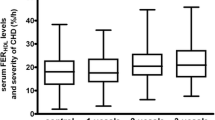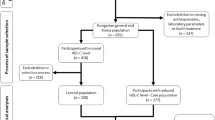Abstract
Dyslipidemias and physicochemical changes in low-density lipoprotein (LDL) are very important factors for the development of coronary artery disease (CAD). However, pathophysiological properties of electronegative low-density lipoprotein [LDL(−)] remain a controversial issue. Our objective was to investigate LDL(−) content in LDL and its subfractions (phenotypes A and B) of subjects with different cardiovascular risk. Seventy-three subjects were randomized into three groups: normolipidemic (N; n = 30) and hypercholesterolemic (HC; n = 33) subjects and patients with CAD (n = 10). After fasting, blood samples were collected and total, dense and light LDL were isolated. LDL(−) content in total LDL and its subfractions was determined by ELISA. LDL(−) content in total LDL was lower in the N group as compared to the HC (P < 0.001) and CAD (P = 0.006) groups. In the total sample and in those of the N, HC, and CAD groups, LDL(−) content in dense LDL was higher than in light LDL (P = 0.001, 0.001, 0.001, and 0.033, respectively) The impact of LDL(−) on cardiovascular risk was reinforced when LDL(−) content in LDL showed itself to have a positive association with total cholesterol (β = 0.003; P < 0.001), LDL-C (β = 0.003; p < 0.001), and non-HDL-C (β = 0.003; P < 0.001) and a negative association with HDL-C (β = −0.32; P = 0.04). Therefore, LDL(−) is an important biomarker that showed association with the lipid profile and the level of cardiovascular risk.


Similar content being viewed by others
Abbreviations
- BMI:
-
Body mass index
- CAD:
-
Coronary artery disease
- CHD:
-
Cardiovascular heart diseases
- ELISA:
-
Enzyme-linked immunosorbent assay
- HC:
-
Hypercholesterolemic
- HDL-C:
-
High-density lipoprotein cholesterol
- LDL:
-
Low-density lipoprotein
- LDL(−):
-
Electronegative low-density lipoprotein
- LDL-C:
-
Low-density lipoprotein cholesterol
- PAF-AH:
-
Platelet-activating factor acetylhydrolase
- TC:
-
Total cholesterol
- TAG:
-
Triglycerides
References
World Health Organization (2006) World Health Statistics. Report. Geneva
Expert Panel on Detection, Evaluation, Treatment of High Blood Cholesterol in Adults (2001) Summary of the third report of the National Cholesterol Education Program (NCEP) Expert Panel on Detection, Evaluation, and Treatment of High Blood Cholesterol in Adults (Adult Treatment Panel III). JAMA 285:2486–2497
Sociedade Brasileira de Cardiologia (2007) IV Diretriz Brasileira sobre Dislipidemias e Prevenção da Aterosclerose; Departamento de Aterosclerose da Sociedade Brasileira de Cardiologia. Arquivos Brasileiros de Cardiologia S88:2–19
Berneis KK, Krauss RM (2002) Metabolic origins and clinical significance of LDL heterogeneity. J Lipid Res 43:1363–1379
Toshima S, Hasegawa A, Kurabayashi M et al (2000) Circulating oxidized low density lipoprotein levels. A biochemical risk marker for coronary heart disease. Arterioscler Thromb Vasc Biol 20(10):2243–2247
Hulthe J, Fagerberg B (2002) Circulating oxidized LDL is associated with subclinical atherosclerosis development and inflammatory cytokines (AIR Study). Arterioscler Thromb Vasc Biol 22:1162–1167
Oliveira JA, Sevanian A, Rodrigues RJ, Apolinário E, Abdalla DSP (2006) Minimally modified electronegative LDL and its autoantibodies in acute and chronic coronary syndromes. Clin Biochem 39:708–714
Sánchez-Quesada JL, Benítez S, Ordóñez-Llanos J (2004) Electronegative low-density lipoprotein. Curr Opin Lipidol 15:329–335
Chen HH, Hosken BD, Huang M, Gaubatz JW et al (2007) Electronegative LDL from familial hypercholesterolemic patients are physico-chemically heterogeneous but uniformly proapoptotic. J Lipid Res 48:177–184
Sevanian A, Hwang J, Hodis H, Cazzolato G, Avogaro P, Bittolo-Bon G (1996) Contribution of an in vivo oxidized LDL to LDL oxidation and its association with dense LDL subpopulations. Arterioscl Thromb Vasc Biol 16:784–793
Sevanian A, Bittolo-Bon G, Cazzolato G et al (1997) LDL− is a lipid hydroperoxide-enriched circulating lipoprotein. J Lipid Res 38:419–428
Chappey B, Myara I, Benoit MO, Mazière C, Mazière JC, Moatti N (1995) Characteristics of ten charge-differing subfractions isolated from human native low-density lipoproteins (LDL). No evidence of peroxidative modifications. Biochim Biophys Acta 1259(3):261–270
Ziouzenkova O, Asatryan L, Akmal M et al (1999) Oxidative cross-linking of ApoB100 and hemoglobin results in low density lipoprotein modification in blood. J Biol Chem 274(27):18916–18924
Gaubatz JW, Gillard BK, Massey JB, Hoogeveen RC, Huang M, Lloyd EE, Raya JL, Yang CY, Pownall HJ (2007) Dynamics of dense electronegative low density lipoproteins and their preferential association with lipoprotein phospholipase A2. J Lipid Res 48(2):348–357
World Health Organization (WHO) (2000) Obesity. Preventing and managing the global epidemic. Report. Geneva (WHO—Technical Report Series, 894)
IDF Clinical Guidelines Task Force (2006) Global guideline for type 2 diabetes: recommendations for standard, comprehensive, and minimal care. Diabet Med 23(6):579–593
Havel RJ, Eder HA, Bragdon JH (1955) The distribution and chemical composition of ultracentrifugally separated lipoprotein in human serum. J Clin Invest 34(9):1345–1353
Lowry OH, Rosebrough NJ, Farr AL, Randall RJ (1951) Protein measurement with the Folin-phenol reagent. J Biol Chem 193(1):265–275
Damasceno NRT, Sevanian A, Apolinário E, Oliveira JMA, Fernandes I, Abdalla DSP (2006) Detection of electronegative low density lipoprotein (LDL−) in plasma and atherosclerotic lesions by monoclonal antibody-based immunoassays. Clin Biochem 39:28–38
Sánchez-Quesada JL, Camacho M, Antón R, Benítez S, Vila L, Ordóñez-Llanos J (2003) Electronegative LDL of FH subjects: chemical characterization and induction of chemokine release from human endothelial cells. Atherosclerosis 166:261–270
Araújo DB, Bertolami MC, Ferreira WP et al (2007) Simvastatin 80 mg and coadministration of simvastatin 10 mg and Ezetimibe 10 mg: effects on LDL(−) and anti-LDL(−) antibodies. Int J Atheroscler 2:272–278
Faulin TES, Sena KCM, Telles AER, Grosso DM, Faulin EJB, Abdalla DSP (2008) Validation of a novel ELISA for measurement of electronegative low density lipoprotein. Clin Chem Lab Med 46:1769–1775
Hodis HN, Kramsch DM, Avogaro P et al (1994) Biochemical and cytotoxic characteristic of an in vivo circulating oxidized low density lipoprotein (LDL−). J Lipid Res 35:669–677
Siqueira AF, Abdalla DS, Ferreira SR (2006) LDL: from metabolic syndrome to instability of the atherosclerotic plaque. Arq Bras Endocrinol Metabol 50(2):334–343
Sánchez-Quesada JL, Benítez S, Otal C, Franco M, Blanco-Vaca F, Ordóñez-Llanos J (2002) Density distribution of electronegative LDL in normolipemic and hyperlipemic subjects. J Lipid Res 43:699–705
Dejager S, Bruckert E, Chapman MJ (1993) Dense low density lipoprotein subspecies with diminished oxidative resistance predominate in combined hyperlipidemia. J Lipid Res 34:295–308
La Belle M, Blanche PJ, Krauss RM (1997) Charge properties of low density lipoprotein subclasses. J Lipid Res 38(4):690–700
Akanji AO, Suresh CG, Fatania HR, Al-Radwan R, Zubaid M (2007) Associations of apolipoprotein E polymorphism with low-density lipoprotein size and subfraction profiles in Arab patients with coronary heart disease. Metabolism 56(4):484–490
Rizzo M, Pernice V, Frasheri A, Berneis K (2008) Atherogenic lipoprotein phenotype and LDL size and subclasses in patients with peripheral arterial disease. Atherosclerosis 197(1):237–241
Acknowledgments
The present study was financially supported by grants from FAPESP (#04/11792-6). The authors acknowledge Dr Paulo Boschcov, former professor at UNIFESP, for his revision of the final version of the manuscript.
Author information
Authors and Affiliations
Corresponding author
About this article
Cite this article
de Queiroz Mello, A.P., da Silva, I.T., Oliveira, A.S. et al. Electronegative Low-Density Lipoprotein is Associated with Dense Low-Density Lipoprotein in Subjects with Different Levels of Cardiovascular Risk. Lipids 45, 619–625 (2010). https://doi.org/10.1007/s11745-010-3439-7
Received:
Accepted:
Published:
Issue Date:
DOI: https://doi.org/10.1007/s11745-010-3439-7




